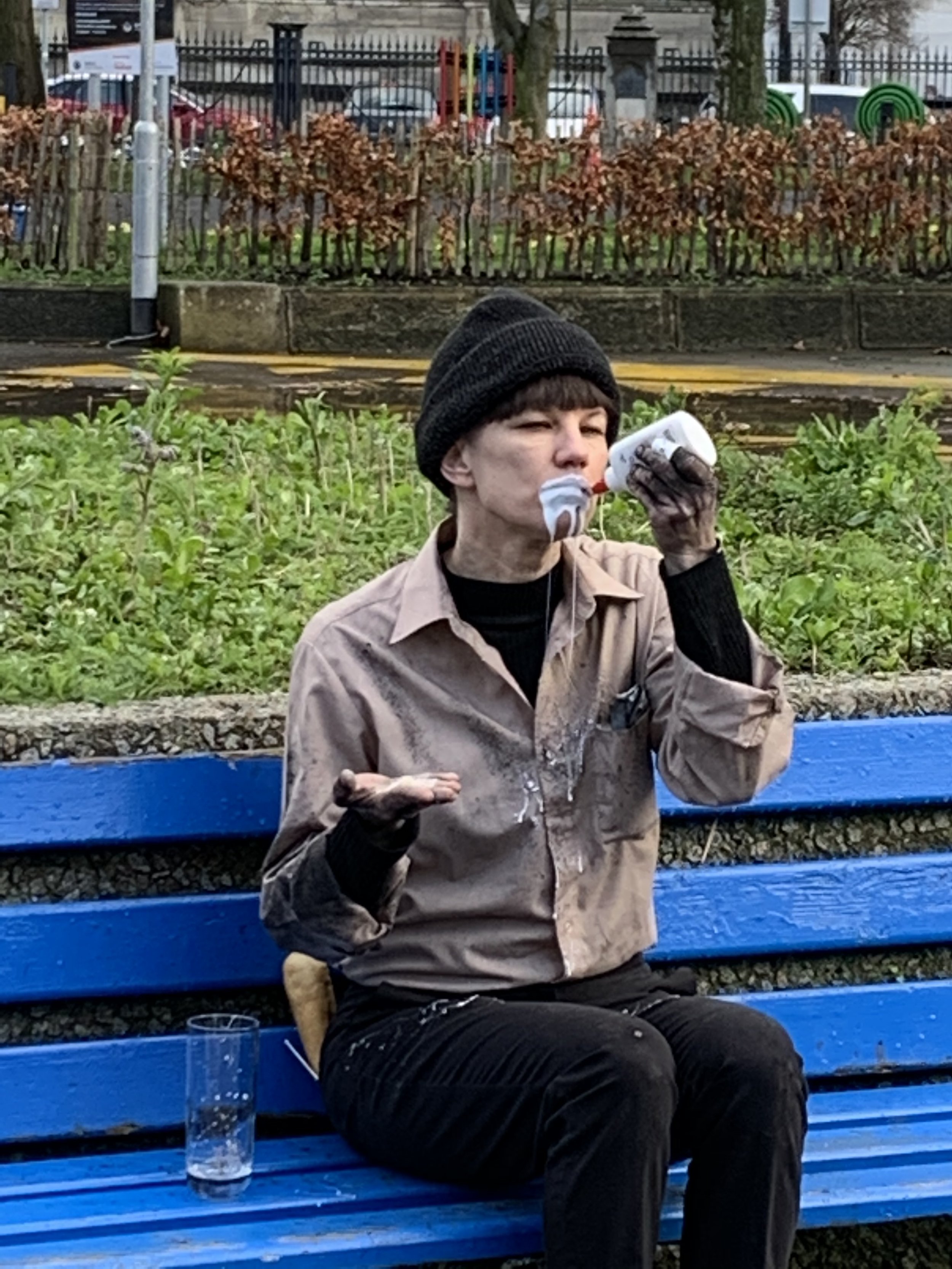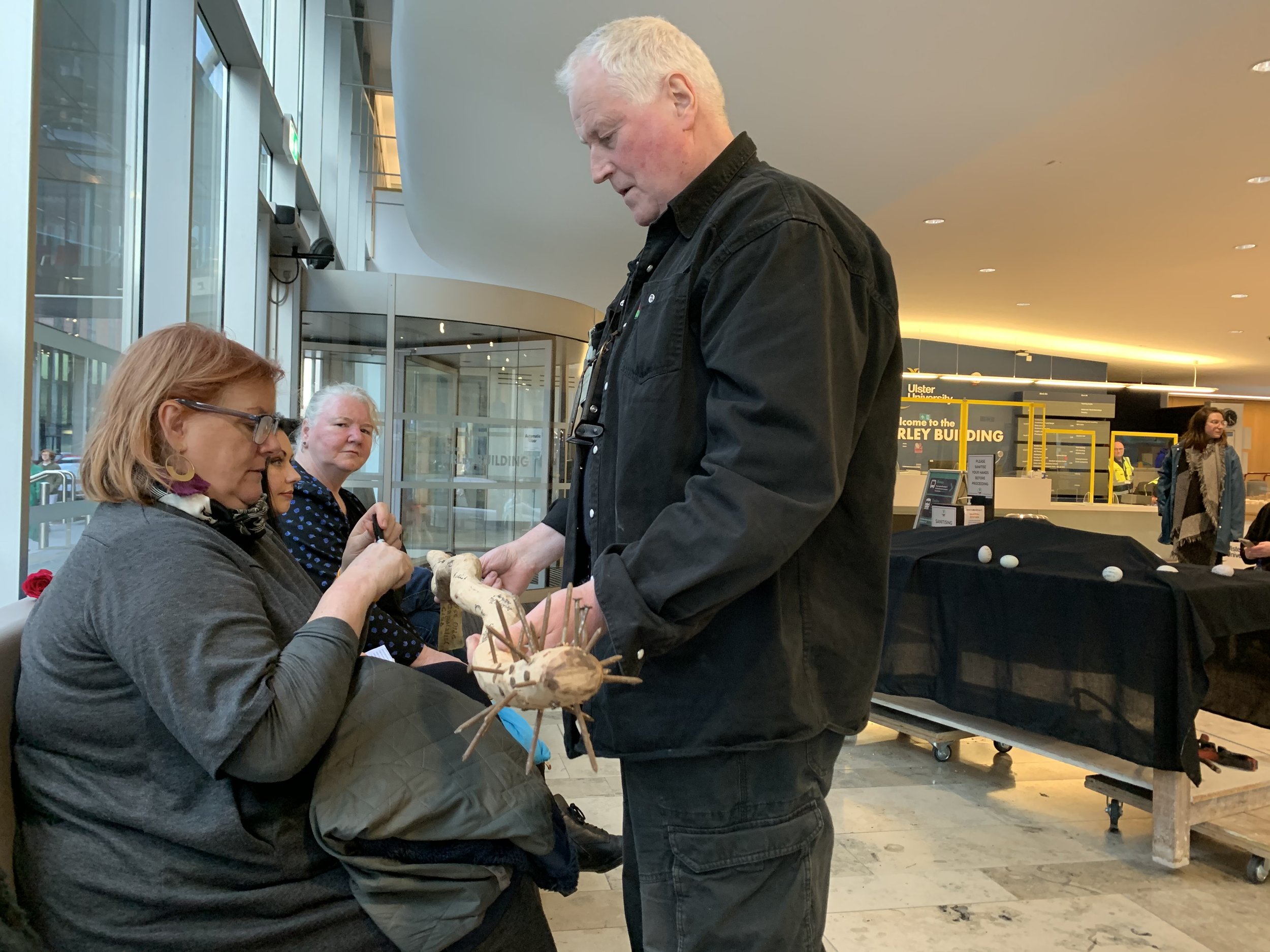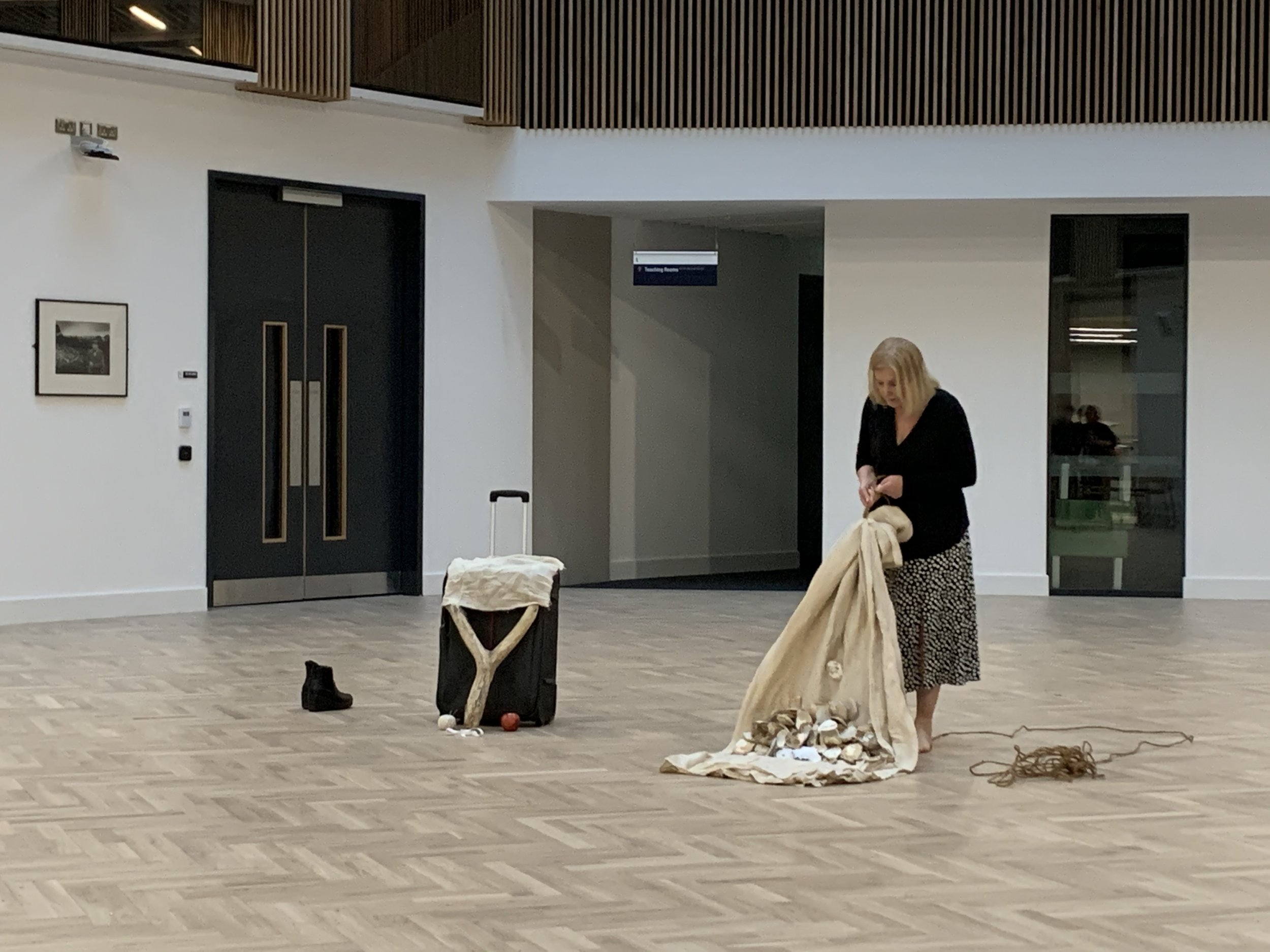Always look for the golden thread
While observing selina bonelli’s performance at Transference Imagine Festival organized by BIFPA & Bbeyond I observed two teenage boys roughly around 15 or 16 years old walk into two long lines of golden thread that stretched across the public plaza. One immediately responded by ducking under with instant reflexes, while the other was frozen in his tracks immediately curious as to why this golden thread was mapping the plaza. This public encounter that occurred in the plaza directly outside Ulster University has remained with me. selina unspooled the golden thread directly from their mouth slowly crossing the fifty-foot terrain of benches and raised flower beds. I started to witness the performance as they were kneeling on the ground in front of an encased starling in a cylindrical tumbler glass. It was haunting to see the sight of this dear creature encased in such a tight, restricted space. Behind selina were four square raised flower beds that were surrounded by blue benches. In the two middle squares one contained a sculpture, while the other remained empty. Perhaps this was an invitation within the urban environment to invite possibility. The two squares at either end contained trees and in conversation with selina in aftermath of the performance they wondered about the roots of these two trees being restricted within these brick walls.
Performance by Selina Bonelli
BIFPA Imagine Festival
After a period of stillness and intense care and consideration the starling was moved to the centre of the empty flower bed. Using the circular rim of the glass the bird was embedded into the earth. This for me was a moving moment in the performance where we were present at memorial ceremony for the bird. As selina wrapped the golden thread around the trees in the slowness of time a connection was made between these distinced architectural squares. Weaving the lines of golden thread across the burial site of the starling heightened the sense that we were participating in a memorial for the starling.
Performance by Selina Bonelli
BIFPA Imagine Festival
Photo by Carron Little
It was at this point the teenage boys encountered the work navigating two cross wires taught across the plaza almost invisible in the light of the day. After binding and connecting these two trees Selina returned to the site of the starling and sat on a bench covering her mouth in PVA glue (wood glue). The white fluid dribbling down their chin in the form of a beard. Bird seed was applied to the glue and then the ritual noise with glasses mapped the space back to the glass architectural building of Ulster University. The movement between the exterior and interior was part of the inspiration for this work. By creating a memorial for the starling, we were confronted by the concept of death and burial as we traversed the various spaces activated in the performance.
‘The Burial Project’ by Marilyn Arsem
photo by Sandra Johnston
The first performance I experienced at the festival was an interactive performance by Marilyn Arsem. I got up at 4:30am that day to catch a flight to Belfast and went directly to the library at Ulster University and was kindly met by Sandra Johnston in the lobby. They had scheduled my time slot for 11am with another woman who I met for the first time in the context of the performance called Cristina. Knowing Marilyn’s work, I had a moment with myself to prepare as she has done other interactive pieces exploring death, so I knew I was walking into a situation that required me to maintain some peace and solace within myself.
We gave each other a big hug and sat down at a round white table in the corner of the Ulster Library. On the table was an updated copy of the Good Friday Agreement written as a living document to inform N. Ireland’s peace and reconciliation process. Marilyn also shared with us a file of research she had been collating about Belfast over her years of visiting and working on projects here. This spoke to the meticulous and detailed oriented approach Marilyn applies to each project she embarks on.
The prompt for the conversation was about burying the hatchet – were we familiar with the phrase? She shared examples from her file along with the origin story of where this phrase came from. She had a map where someone had drawn all the underground waterways in Belfast that had been buried underground with concrete. We then had an open conversation about ‘burying the hatchet’. The person who I was with shared that she had bought two burial plots for her and her parents that had cost 150 pounds each. I was intrigued at how cheap this was having dealt the organization of my father’s funeral costs that amounted to 7000 pounds. In the aftermath of the meeting Cristina and I shared much deeper conversations entering into a space of intimacy.
We were also given a task, Marilyn called it ‘homework’ to create an action and document it and share it with Marilyn as she plans to create a booklet out of these actions of ‘burying the hatchet’. This interactive performance exchange or shall we call it an ‘encounter’ moved people in very different ways. In the aftermath of the encounter Marilyn shared that the conversations went in diverse directions inspired by the prompt. In my recent conversation with another artist from Northern Ireland they have already ‘buried the hatchet’. I still have to do my action, but it immediately came to mind what I need to bury in that moment.
Performance by Brian Connelly at BIFPA Performance Art Festival, 2023 Belfast, N.Ireland
photo by Carron Little
Continuing the theme of ‘burying the hatchet’ which in some funny ways could be applied to all performative actions, as we face our fears, or facilitate a rebalance. In Brian Connelly’s work we were invited to write our wishes on eggs. The audience was instructed to stand their egg on the table. This is a very tricky thing to do with a round object, but some people were able to work their magic. One question that I’m still pondering is were the eggs hardboiled or blown? Brian then invited each member of the audience to write on a stick which had nails in the end, it looked like a special ploughing implement. The prompt written as an instruction on label attached to his jacket pocket said write an abuse of power on the tool. Were we all being invited to bury the hatchet of the abuse of power in this moment? (One can but hope.) After each person in the audience had participated the atmosphere quickly switched as Brian threatened to smash the eggs with wishes – people dashed to rescue their eggs before Brian smashed the table with the tool embedding it violently into the table. A surprisingly shocking amount of violence and aggression was used here switching the dynamics of the space as Brian macheted the stick into the table. The trust was slowly rebuilt as red ribbon were woven in and out of the basket holding all the wishes and reconnecting the majority of the audience in a circular web of love, of red ribbon.
Performance by Brian Connelly
Photo by Carron Little
Performance by Bernadette Hopkins at BIFPA Performance Art Festival, Belfast, N.Ireland
photo by Carron Little
The air was moved. There is a line in one of Seamus Heaney’s poems where he talks about the ‘thin air’ and in Bernadette Hopkins performance the air was a co-performing collaborator in the work. The audience was transported to a different space at Ulster University that was an atrium space that reached to the sky. These are the administrative offices in the school, and we were taken to a place where the land meets sky in the space and time of the performance.
Bernadette began the piece by moving around in circles in the space dragging a white canvas cloth filled with seashells. It felt like she was moving a wave as she mapped the space. The gentle movement of the shells rubbing each other echoed the sound of the sea. She then formed a circle of the shells that she gravitated back to throughout the performance. At the second station there was a table where some wooden boxes with objects inside were located. At one point a tampon was removed from a tube in a box and the tube was used to reverberate the air through the space. The air moved in synchronicity with the sound of the rain on the roof both pausing at the same moment.
Performance by Bernadette Hopkins
Photo by Carron Little
The removal of all the tampons from their tubes became one of the central actions in this poetic piece. Bernadette returned to the circle of shells and using a piece of Y-shaped driftwood she began to catapult the tampons into the space. As I reflect on this action now their might have been a counting taking place with the audience in mind. Removing enough tampons from each tube so that each member of the audience could participate in the next action. A feminization, a reclamation of space was in question as these femme objects flew like bees through the air – some flying and floating with slow grace others determined to be grounded with haste. After the landing of tampons, we were invited to blow air through the empty tampon tubes experimenting with their capacity for sound variation. The movement of the audience’s air around the space felt like an act of liberation after years of intermittent mask wearing. The sound of breath circulating around the space felt like a release and in the thinness of time a return to the whispering sea where the performance began. A meeting of horizons in the circular motion of the score.
Performance by Yaryna Shumska at BIFPA Performance Art Festival, Belfast, N.Ireland
photo by Sandra Johnston
The sea of the audience moved to another atrium space located in the Belfast School of Art at Ulster University. Yaryna Shumska has been an artist in resident as part of the BIFPA festival & Imagine Festival program for three weeks in Belfast as part of an exchange created with artist in Ukraine.
Yaryna’s performance began with her walking in a straight line towards the audience from the farthest point in the modern architectural space. The resonance of each step echoing through the space of hard surfaces. She switched direction to the diagonal bursting into a folk-dance step that she has studied for many years in Ukraine. Walking out of the performance area she had activated, she dragged four rubber buckets of cement/soil mix into the space and then placed a bicycle behind. She then turned the bike upside down spinning the wheels – the clicking of the chain as it spun the wheels combining human and machine in the act of rotation. The buckets where evenly placed and became stepping stones as she hoped between each one massaging the soil mix with her feet. The soil/cement mix was poured into a body mass on the floor. As she stood in the island of soil she began to throw the earth into the air. Each person sensing the patter of falling soil as it fell around her body. After some time, she was moved to lie in the soil letting it fall over her body. This image of the earth falling around her was so poetic and moved people in the audience to tears. The atmosphere was so palpable, and the end came with her spinning like a whirling dervish. She spun so much she couldn’t hold herself up as she came to an end, falling to the floor. As an audience space collapsed in the time of this work. We were truly moved and captivated through movement and images she brought. It is in these moments that the element of curioisity can grow like a golden thread moving through space. As a performer she held our hearts in her hands for this moment sending our imaginations on wild journeys of the heart and soul.
Performance by Yaryna Shumska
Photo by Sandra Johnston
Performance by Yaryna Shumska
Photo by Sandra Johnston
There were twenty performances over the course of two days and a phenomenal production team who worked tirelessly around the clock to facilitate smooth transitions, to document, and share this online simultaneously plus coordinate members of the public participating in the work. This blog post just highlights a few of the artists who participate in our community and ones that touched me to write about. There were far more performances that truly deserve space and textual analysis.
Text by Carron Little (organizer of Out of Site Artist Collective)












